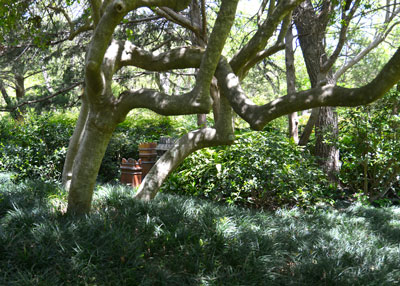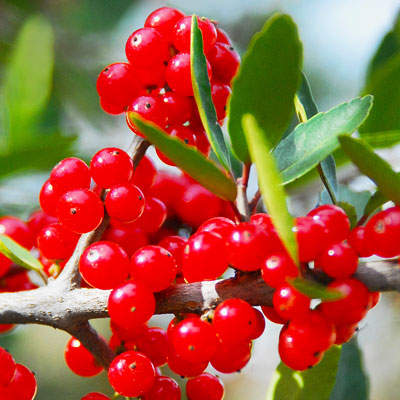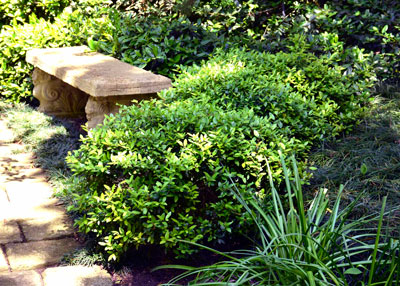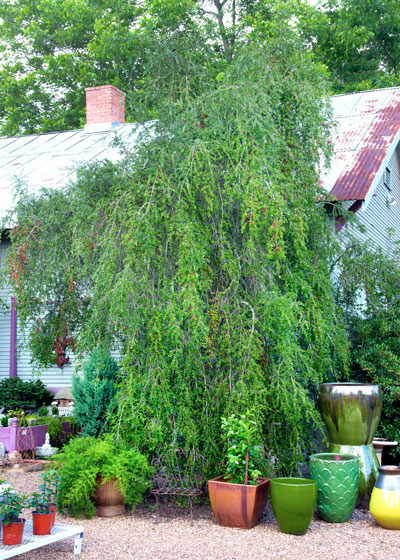My Best Plant Ever

Photo: Exotic branching of 75-year-old yaupon holly tree is a focal point in the Sperry landscape. (Antique English chimney pots in the background.)
It was 1981. Our family had moved to rural Collin County only three years earlier. I was busily taming our 11 acres of briars, redcedars, honeysuckle, poison ivy and pecans, trying to establish a nice, natural landscape.
One particular area defied my design skills. It was an open vista to the county road that runs past our house – and an equally open vista from that road back into our living room. I had taken out the one gnarly eastern redcedar that had provided some small amount of privacy. It was just too ugly to tolerate. But that left me with a big open spot.
I was on a sales call at one of my nursery sponsors, and there on his front lot was the most glorious yaupon holly tree I’d ever seen. It was October. He had brought it in the previous winter, but no one had bought it.
I was ready to write out my check the moment I saw it. But his reply stopped me cold: “I am so sorry. A lady just came in two hours ago and told us she wanted it. I just haven’t gotten the “Sold” tag hung on it yet.
Discouraged, I just kept on looking. But I couldn’t get the memory of that great tree with its beautiful branches out of my mind.
The following March I was back in that nursery. As I drove in, much to my surprise, there sat my old friend. Still wearing its “Sold” tag, but obviously in the same spot. When I asked the nurseryman about it, he said, “Funniest thing. That lady came back in here this morning – couldn’t have been more than two hours ago. She said she couldn’t afford it and would have to cancel the sale. I just hadn’t gotten the tag taken off yet.”
They delivered and planted my yaupon just a few days later. It’s a tree that got its start in some cow pasture in South Central Texas. Its trunks and branches were a couple of inches in diameter, so it had obviously been in that field for 25 to 40 years. The cows had browsed on it, and they’d brushed against it repeatedly. And those actions gave my tree its delightful branching.

Photo: This is our “hero tree” from the county road viewpoint. For more than 35 years it’s been providing us privacy and adding beauty to its surroundings to boot.
This is a male tree. Yaupons have male flowers (with their pollen) on one plant and female flowers (that can produce fruit) on another. That was a side-bonus for me, because I knew the male plant would grow larger faster, since it wasn’t having to share moisture and nutrients with multitudes of fruit.
In this day and age, yaupons are much more commonly grown in nursery settings, so you’ll find much more regular branching and uniform habit. But that doesn’t mean you couldn’t pick up where the cattle left off.
____________________________________________________________________
Yaupon holly (Ilex vomitoria) is native to South Central and East Texas, most commonly growing in post oak woodlands where it can form impenetrable thickets.
Yaupons were grown as large shrubs in Texas landscapes until the 1950s, but enterprising landscapers discovered they could easily remove lower branches and convert a large shrub into a fabulous small landscaping tree.
From that time, many selections of the original native species have been introduced. Some have yellow berries. Some weep. Some are extremely vertical and many are dwarf. It’s a great group of landscaping plants.

Photo: Small yaupon holly berries are brilliant red. They persist all winter.

Photo: Dwarf yaupon holly is one of our finest low shrubs for sun or shade.

Photo: Weeping yaupon holly is a very large plant, so give it ample room. It covers itself with red berries all winter.
